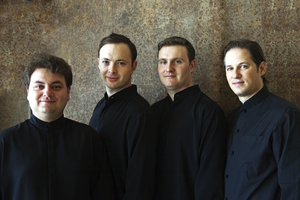Jerusalem Quartet in perfect harmony at Rackham Auditorium performance
When the foursome of a string quartet play like one vibrating, breathing body, it’s a miraculous, exalting thing. That’s how the Jerusalem Quartet — Alexander Pavlovsky and Segei Bresler, first and second violin; Ori Kam, viola; Kyril Zlotnikov, cello — played Thursday evening at Rackham Auditorium, where they appeared under University Musical Society auspices.

Jerusalem Quartet publicity photo
It was the quartet’s third Ann Arbor visit — but the first with new violist Kam, a spectacular, rich-voiced replacement for Avihai Grosz, now principal viola with the Berlin Philharmonic. Next year would not be too soon for a fourth visit here; theirs is some of the most exquisite, exciting quartet playing to be heard anywhere — witness the applause that followed each movement of the opening Mendelssohn quartet, Op. 44, No. 2 in E Minor.
With Mendelssohn to start, Brahms to finish and a 1969 quartet by the Russian-born Israeli composer Mark Kopytman in between, the announced program offered appealing contrasts of mood and style. The quartet capped it all with an encore of the Adagio from Haydn’s String Quartet in F Minor, Op. 20, No. 5, a rocking sicilienne played with transparency and gracious shaping, to say nothing of singing ornament, especially from first violinist Pavlovsky. It’s no surprise their recording of the work (on Harmonia Mundi) just won the group a second BBC Music Award.
I’d give them an award for last night’s Mendelssohn, too. The opening that grew like a tender shoot pushing skyward, the ground throbbing underneath; the intimacy when the textures grow spare; the incisiveness and drive of the playing; the fleetness and humor of the buzzing figure in the scherzo; the throaty lyricism of Kam’s viola; the singing of Zlotnikov’s cello and Pavlovsky and Bresler’s violins; the fade to the perfect, light-as-air Mendelssohnian close. Those were just a few things that kept me rapt and smiling. I loved the dance in the last movement. I loved the sense of dialogue, the sense of impulsion and heat-driven playing, the focused sound, the unity of purpose. It was a wow.
Darker hued, the Kopyptman String Quartet No. 3 was no less satisfying. It’s complex music, eventful and layered, full of shifting patterns that form a puzzle of pizzicatos and fragments of Jewish dances and sweet first-violin statements received with gruff, Shostakovich-like down-bow rejoinders from the viola and second violin. The players captured the music’s intensity as well as its melancholy, coloring and shading their sound remarkably throughout.
How is it that just a few notes in the opening of the Brahms Quartet in C Minor, Op. 51, No. 1, gave us the whole story of what to expect? You immediately knew you were in for long musical lines, a flow of sound that would take you all the way to the end of the first thematic statement and show you the big architecture. The tuning and intonation were glorious in the two inner movements, and the finale was a great reminder that in music as in life, timing is everything. This group has got it, in a big way.
Susan Isaacs Nisbett is a free-lance writer who covers classical music and dance for AnnArbor.com.


Comments
Roadman
Mon, Oct 25, 2010 : 11:15 a.m.
Henry Herskovitz indicated to City Council that he was going to organize a demonstration against the Quartet. Did it ever materialize?
CMSMW
Fri, Oct 22, 2010 : 5:20 a.m.
The intermezzo in the Brahms is my early candidate for the highlight of the 2010-2011 UMS season.